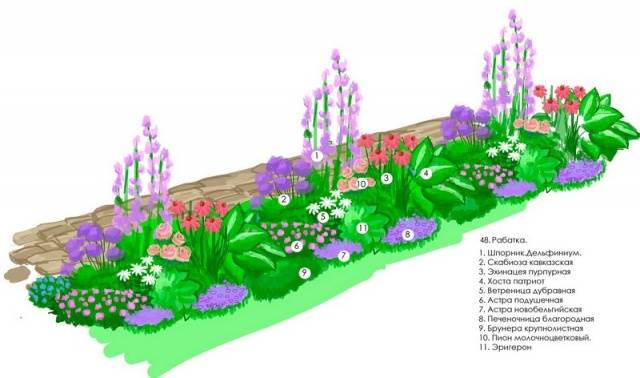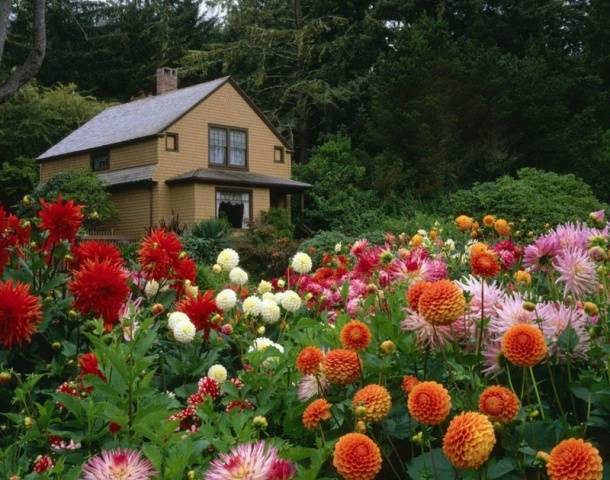Content
Flower beds serve as decoration for the local area, garden or park. Properly designed flower beds simply attract attention, are an island of bright colors, but, in addition, they also perform an important function - they help to divide and organize the space on the site. Landscape designers design and decorate flower beds, and this is not as simple as it might seem at first glance. It is necessary to carry out accurate calculations, work on drawings, color schemes, and take into account the characteristics of the plants included in the flower garden.
It is not at all necessary to pay professionals - it is quite possible to decorate a flowerbed with your own hands. And to make this easier, beginners are advised to choose perennial plants and draw up simple diagrams.
What are flower beds like?
Flower beds can differ not only in shape, but also in content, and the shades are also different colors, and the height of the plants, and the period of their flowering - all this must be taken into account by the gardener when implementing the scheme.
A schematic representation of the future flower garden is necessary in order to:
- properly organize the space on the site;
- take into account the size and shape of the free space allocated for the flowerbed;
- choose the most harmonious composition from flowers of various shades;
- correctly distribute the flowers inside the flowerbed and along its contour, taking into account the height and branching of the plants.
Among other things, A diagram of a flower bed depicted on paper and colored with colored pencils will help you visualize the picture and understand what a real flower arrangement will look like.
Flower beds can be of several types in shape, the most popular are:
- Modular flower beds - a group of plants combined into one composition with blind area elements, garden paths, steps, small architectural compositions, such as garden sculptures, artificial ponds, and other decorative elements.
- Mixborders are a combination of a wide variety of plants; flower beds of this type are made in free form, and their size is also unlimited. Most often, rectangular elongated mixborders are used to decorate garden paths or hedges.
- Solitaires must have at least one common feature: the shape of the inflorescences, the shade of the plants, the height of the covering, the type of flowers. Such repeating flower beds with a common feature must be in close proximity to each other and clearly visible, otherwise the tapeworms will not be perceived as a single composition.
- Discounts – more strict flower beds. They should have clearly defined contours, the ratio of their width to length is 1:3, and the ridges should be filled with solid colors or simple geometric patterns.It is ridges that most often border garden paths; they are also used to divide large flower beds into zones.
- Curbs They have a small width (up to 50 cm) and are distinguished by plants of small height. Such compact flower liners are used to limit larger flowerbed elements.
- Rockeries They are also called rock gardens, because both plants and boulders are used in their design.
- Rock gardens They differ from rockeries in that only plants native to the flora of the Alps or other low-growing and compact flowers are planted in them.
For example, you can opt for a mixborder or a modular flowerbed (as in the photo).
Composition
Making a flower bed of perennials is good, first of all, because such flowers do not have to be planted every year, moreover, most perennial flowers are not whimsical and tolerate cold winters well.
That is why a beginner only needs to draw a diagram of a flowerbed once, transfer it to the plot and fill it with flowers, after which he can enjoy the beauty of the plants arranged in the composition for several years.
A flowerbed of perennials with your own hands, as already mentioned, should be as simple as possible. For beginner gardeners, the following simple flower arrangements are suitable:
- Island. It is a round or oval flowerbed located in a free area of the garden. Often such flower arrangements are used to fill vacant lots—places without trees or other vegetation. The boundaries of the island's flower bed may well be fuzzy, slightly blurred.This flower garden does not have to be divided into sectors - the flowers on the island can be arranged freely, the main thing is that they match in tone and height. Basically, a flowering island is filled in several tiers: the tallest plants (80-150 cm) are planted in the center of the circle, then they are bordered with flowers of medium height (from 40 to 70 cm), and the borders of the island are outlined with low-growing flowers, the height of which does not exceed 30 cm The same compact bushes can be used to fill the empty areas of the flower bed formed after planting all the flowers of the composition. You can arrange a flowerbed in the form of an island close to a fence or building, only in this case, it is a semicircle in which the background is filled with the tallest flowers, and low-growing plants are planted in front (a sample is shown in the photo).
- Living fence performed near hedges or on both sides of the garden path. To design such a composition, different types of flowers are planted in the form of a line, the width of which can vary.
- Illusion is a composition reminiscent of a natural landscape. The most popular embodiment of this idea is a flowing stream. So, flowers (usually blue and blue shades) are planted on a flowerbed in the form of a snake, placing the plants closely to each other. “Banks” are created from flowers of a contrasting shade, placing them along the contour of the “bed” of the stream (shown in the photo below). Such a composition requires quite a lot of space, so it is better not to use the illusion in small areas.
- Cover or carpet - This is a continuous layer of flowers of the same height. Most often, plants of the same species are used for such flower beds, but different shades of flowers are chosen. From the side, the flowerbed-carpet looks like a fluffy and voluminous blanket.
- Fantasy pattern in the shape of a heart, a large flower, a letter or an inscription is considered a more complex composition, because the effectiveness of such a flower bed depends entirely on the quality of its execution - the borders of the flower bed must be clear, only in this way will the viewer appreciate the designer’s idea.
Perennial flowerbed for beginners
Having decided on the type of flowerbed, its size and location, we begin to directly implement the idea. And first, you need to draw your flower garden on a large sheet of paper. After the drawing is completed, it needs to be colored with colored pencils, choosing shades that suit each other.
An even simpler way is to use two contrasting colors. It could be blue and yellow, red and white, and so on.
In recent years, ombre color schemes for flower beds have become increasingly popular. This is when one shade smoothly transitions into another. Another way of combining colors is called a gradient. Perennials for such a flower bed must be selected especially carefully; their shades should be pastel, so the transition boundaries will be extremely smooth. An example of a flowerbed of perennials using the ombre type would be the following transition of tones: terracotta, pink-peach, pink, pale pink, cream. A novice gardener just has to choose perennials with flowers of the right shade.
Perennials are divided into many groups, but their main division is according to their whims.This is what should first of all concern a novice gardener - what kind of care will be required for flowers from the same flower bed.
After all, if alone perennials require shade, others grow only in the sun, others need to be watered every day, and for others, excessive humidity is destructive, the flowerbed will simply die, and there will be no talk of any beauty.
All perennials are divided into three main groups:
- Unpretentious perennials Suitable for almost any flower bed. These plants are undemanding in terms of lighting, watering, and soil composition - they grow in any conditions. Another important characteristic of unpretentious perennials is that the flowers do not have to be replanted every year and they tolerate frost well without shelter. All perennial plants need: watering during dry periods and forming bushes in spring. This group includes the following flowers: geranium, acolyte, brunnera, helenium, mallow, chistema and sedum, doronicum, poppy.
- Moderately labor-intensive perennials they are not particularly capricious, they do not need daily care, but the gardener will have to take into account the growing conditions of such plants (lighting, soil type, watering schedule, fertilizers). Also, perennials from the second group need to be replanted and divided at least once every two to three years. These include gentian, arabis, cornflower, clematis and armeria.
- The most difficult perennials They belong to the third group and require regular care, compliance with growing conditions, and constant attention from the gardener. Such flowers often get sick, attract insect pests, and do not tolerate cold well.Such “sissies” include chrysanthemums, gladioli, roses, bulbous flowers, dahlias, begonias, hyacinths and others.
When choosing perennials for your flowerbed, you need to give preference to plants from the same group, then caring for the flower garden will be as simple as possible, and the flowers themselves will feel comfortable.
Making a flower bed of perennials
The plan has been drawn up, the diagram is there, the flowers have been bought - all that remains is to plant the plants in the soil. To begin with, the selected area is cleared, stones and plant roots are removed. Then the soil needs to be fertilized with complex fertilizers and dug to a depth of about 40 cm (a spade bayonet).
Depending on the composition of the soil in the area, it is necessary to perform drainage or, conversely, take measures to retain water (which is necessary on sandy soils, for example). For drainage, peat, coarse river sand, and small pebbles are used; these materials are poured in a 5-10-centimeter layer at the bottom of the area under the flower bed. Clay or black soil can be used as a water retainer.
The height of the flower bed should be 10-15 cm so that during precipitation, water does not stagnate in the flowers and harm them.
Now the ground is leveled with a rake and the flower garden diagram is transferred to the surface.
This can be done with a wooden peg or lime powder. Now all that remains is to plant the plants in the flowerbed, trying to do this as carefully as possible, following the drawn plan.
When planting flowers, do not forget about the tiers of the flower bed. In addition, the gardener must understand that perennials grow for more than one season, so young plants need to be given room to grow.
Results
Finally, it should be noted that it is very important to select perennials that have approximately the same flowering time. After all, a flowerbed with blooming buds and dried flowers located nearby looks more than untidy, and the composition will be ruined.
Beginners should take this into account and choose spring, summer or fall blooming perennials for their garden. Although Today there are many types of plants that bloom throughout the season: violets, pansies, roses, evergreen shrubs and ornamental grasses.
Photos of flower beds of perennial flowers will help a novice gardener make up his mind, and don’t forget that it’s better to start simple.

























